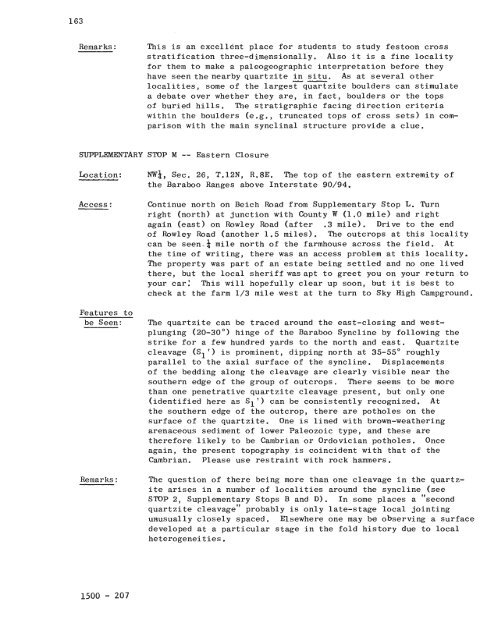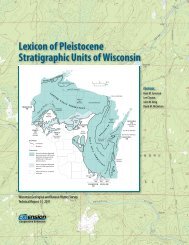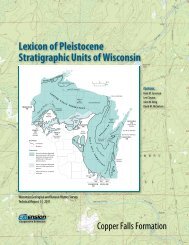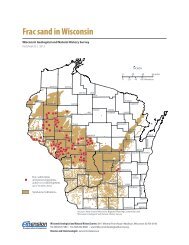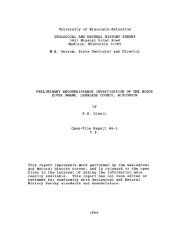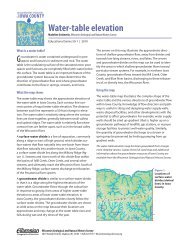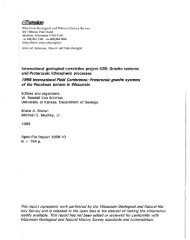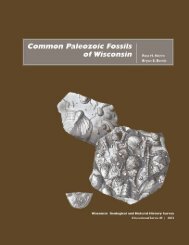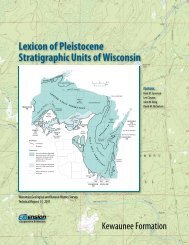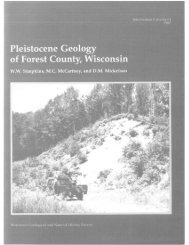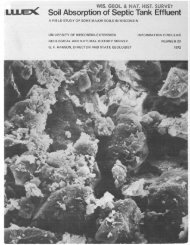IC14. Geology of the Baraboo District, Wisconsin: A description and ...
IC14. Geology of the Baraboo District, Wisconsin: A description and ...
IC14. Geology of the Baraboo District, Wisconsin: A description and ...
Create successful ePaper yourself
Turn your PDF publications into a flip-book with our unique Google optimized e-Paper software.
Remarks : This is an excellent place for students to study festoon cross<br />
stratification three-dimensionally. Also it is a fine locality<br />
for <strong>the</strong>m to make a paleogeographic interpretation before <strong>the</strong>y<br />
--<br />
have seen <strong>the</strong>nearby quartzite in situ. As at several o<strong>the</strong>r<br />
localities, some <strong>of</strong> <strong>the</strong> largest quartzite boulders can stimulate<br />
a debate over whe<strong>the</strong>r <strong>the</strong>y are, in fact, boulders or <strong>the</strong> tops<br />
<strong>of</strong> buried hills. The stratigraphic facing direction criteria<br />
within <strong>the</strong> boulders (e.g., truncated tops <strong>of</strong> cross sets) in com-<br />
parison with <strong>the</strong> main synclinal structure provide a clue.<br />
SUPPLEMENTARY STOP M -- Eastern Closure<br />
Locat ion: *, Sec. 26, T.l2N, R.8E. The top <strong>of</strong> <strong>the</strong> eastern extremity <strong>of</strong><br />
<strong>the</strong> <strong>Baraboo</strong> Ranges above Interstate 90/94.<br />
Access : Continue north on Beich Road from Supplementary Stop L. Turn<br />
right (north) at junction with County W (1.0 mile) <strong>and</strong> right<br />
again (east) on Rowley Road (after .3 mile). Drive to <strong>the</strong> end<br />
<strong>of</strong> Rowley Road (ano<strong>the</strong>r 1.5 miles). The outcrops at this locality<br />
can be seen-$ mile north <strong>of</strong> <strong>the</strong> farmhouse across <strong>the</strong> field. At<br />
<strong>the</strong> time <strong>of</strong> writing, <strong>the</strong>re was an access problem at this locality.<br />
The property was part <strong>of</strong> an estate being settled <strong>and</strong> no one lived<br />
<strong>the</strong>re, but <strong>the</strong> local sheriffwasapt to greet you on your return to<br />
your car! This will hopefully clear up soon, but it is best to<br />
check at <strong>the</strong> farm 1/3 mile west at <strong>the</strong> turn to Sky High Campground.<br />
Features to<br />
be Seen: The quartzite can be traced around <strong>the</strong> east-closing <strong>and</strong> west-<br />
plunging (20-30°) hinge <strong>of</strong> <strong>the</strong> <strong>Baraboo</strong> Syncline by following <strong>the</strong><br />
strike for a few hundred yards to <strong>the</strong> north <strong>and</strong> east. Quartzite<br />
cleavage (Sl ' ) is prominent, dipping north at 35-55O rough1 y<br />
parallel to <strong>the</strong> axial surface <strong>of</strong> <strong>the</strong> syncline. Displacements<br />
<strong>of</strong> <strong>the</strong> bedding along <strong>the</strong> cleavage are clearly visible near <strong>the</strong><br />
sou<strong>the</strong>rn edge <strong>of</strong> <strong>the</strong> group <strong>of</strong> outcrops. There seems to be more<br />
than one penetrative quartzite cleavage present, but only one<br />
(identified here as Sll) can be consistently recognized. At<br />
<strong>the</strong> sou<strong>the</strong>rn edge <strong>of</strong> <strong>the</strong> outcrop, <strong>the</strong>re are potholes on <strong>the</strong><br />
surface <strong>of</strong> <strong>the</strong> quartzite. One is lined with brown-wea<strong>the</strong>ring<br />
arenaceous sediment <strong>of</strong> lower Paleozoic type, <strong>and</strong> <strong>the</strong>se are<br />
<strong>the</strong>refore likely to be Cambrian or Ordovician potholes. Once<br />
again, <strong>the</strong> present topography is coincident with that <strong>of</strong> <strong>the</strong><br />
Cambrian. Please use restraint with rock hammers.<br />
Remarks : The question <strong>of</strong> <strong>the</strong>re being more than one cleavage in <strong>the</strong> quartzite<br />
arises in a number <strong>of</strong> localities around <strong>the</strong> syncline (see<br />
'1<br />
STOP 2, Supplementary Stops B <strong>and</strong> Dl. In some places a second<br />
quartzite cleavagev1 probably is only late-stage local jointing<br />
unusually closely spaced. Elsewhere one may be observing a surface<br />
developed at a particular stage in <strong>the</strong> fold history due to local<br />
heterogeneities.


